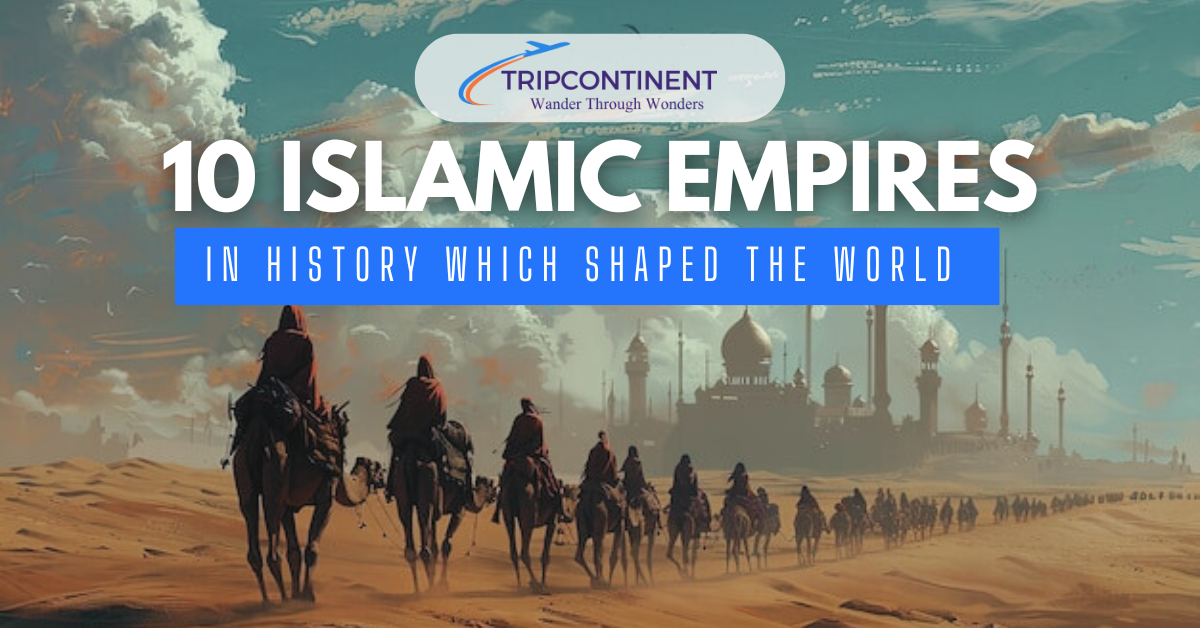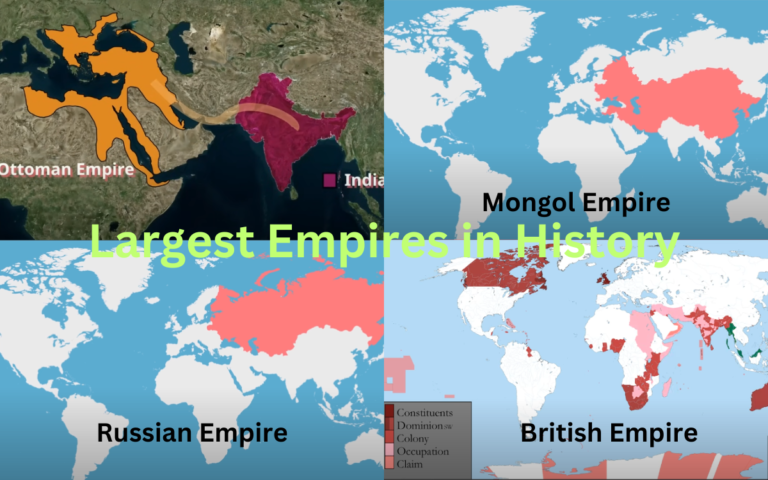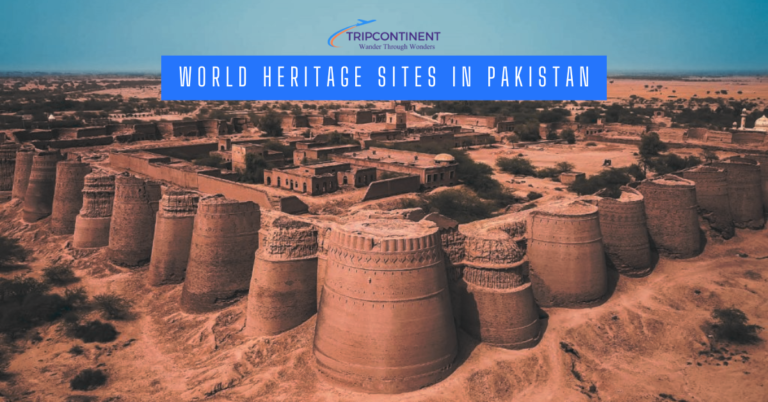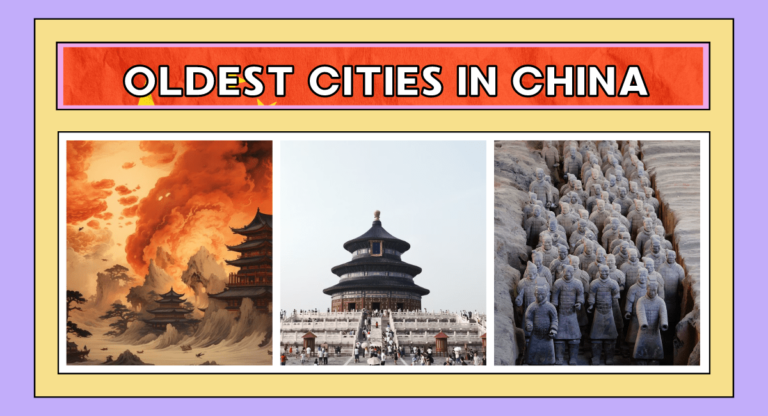10 Islamic Empires in History Which Shaped the World
An Islamic Empire, commonly referred to as the “Caliphate,” is a unique form of monarchical government that emerged in 7th century Arabia. This political entity is founded on the principle of succession to the Islamic State established by Prophet Muhammad (PBUH). The ruler of this state, known as the caliph, serves as both the political and religious leader of the Muslim community. The concept of the Caliphate represents a fusion of spiritual and temporal authority, aiming to govern in accordance with Islamic principles and laws.
The Medieval Islamic Empire refers to a vast and diverse collection of territories united under Islamic rule during the Middle Ages. At its zenith in the mid-7th century, this empire stretched across an impressive expanse of land, encompassing the Middle East, extending westward across North Africa and into Spain, and reaching as far east as India. This period marked an era of remarkable expansion, cultural synthesis, and intellectual flourishing. The Islamic empires that rose and fell during this time played pivotal roles in shaping world history, fostering advancements in science, philosophy, arts, and commerce.
The following exploration delves into the top 10 Islamic Empires, each of which left an indelible mark on the tapestry of human civilization, contributing to the rich and complex heritage of the Islamic world.
List of the 10 Islamic Empires in History
Here is the list of Islamic Empires in history.
- Rashidun Caliphate
- Umayyad Caliphate
- Abbasid Caliphate
- Golden Horde
- Fatimid Caliphate
- Seljuk Empire
- Ayyubid Dynasty
- Timurid Empire
- Mughal Empire
- Ottoman Empire
1. Rashidun Caliphate
The Rashidun Caliphate was the first big Muslim government after Prophet Muhammad died in 632 CE. “Rashidun” means “Rightly Guided” in Arabic. This name was given to the first four leaders who came after Muhammad.
These four leaders were:
- Abu Bakr
- Umar ibn al-Khattab
- Uthman ibn Affan
- Ali ibn Abi Talib
The Rashidun Caliphate lasted for 30 years. During this time, the Muslim lands grew very quickly. They spread out from Arabia into lands that used to belong to the Persians and Byzantines.
The Rashidun time was known for:
- Being simple and not fancy
- Treating people equally
- Following the rules Muhammad had set up
They did some important things:
- Started government offices called diwans
- Counted the people (like a census)
- Made a Muslim calendar
At first, the main city was Medina, where Muhammad had lived. Later, when Ali was the leader, they moved to a city called Kufa.
The Rashidun leaders faced some big challenges:
- They had to decide how to rule a growing empire
- There were sometimes disagreements about who should be the next leader
- They had to deal with people who didn’t want to follow the new Muslim rules
Even though it was a short time, the Rashidun period is very important in Muslim history. Many Muslims see it as a perfect time when things were done the right way. The Rashidun time ended sadly. Ali, the last of the four leaders, was killed in 661 CE. After this, a new group called the Umayyads took over. Today, many Muslims look back at the Rashidun time as an example of good leadership and fairness. The things they did and the way they ruled still influence Muslim thinking about government and society.
2. Umayyad Caliphate
The Umayyad Caliphate was a big Muslim empire that started in 661 CE. It was the second major Islamic government after Muhammad’s death. Muawiya ibn Abi Sufyan, from an important family in Mecca, started this empire. The Umayyads took power after a big fight among Muslims. They moved their main city to Damascus in Syria, which was different from before when the main city was Medina.
Under the Umayyads, the Muslim empire grew very big, very fast. It became one of the largest empires in the world at that time. They conquered lands from Spain in the west to parts of India in the east.
The Umayyads made some important changes:
- They made Arabic the main language for government work.
- They built many beautiful buildings, like the Dome of the Rock in Jerusalem.
- They created a new money system using coins.
- They improved farming by building canals and dams.
But the Umayyad rule had problems too:
- Many people thought they favored Arabs over other Muslims.
- There were fights within the ruling family.
- Some people didn’t like how they chose their leaders.
The Umayyads were good at art and culture. They built grand mosques and palaces. They also helped science and learning grow. Poets and scholars were welcome in their courts. However, not everyone was happy with the Umayyads. Many non-Arab Muslims felt left out. Another powerful family, the Abbasids, started to gain support.
In 750 CE, after about 90 years of rule, the Umayyads were overthrown by the Abbasids. This was a big change in the Muslim world. Most of the Umayyad family was killed, but one member escaped to Spain. He started a new Umayyad government there, which lasted for many more years. Even though the Umayyad Caliphate ended, it left a big mark on history. It helped spread Islam to many new places and created a rich culture that mixed Arab, Persian, and other traditions.
3. Abbasid Caliphate
The Abbasid Caliphate took over from the Umayyads in 750 CE. They were named after Abbas, an uncle of Prophet Muhammad. The Abbasids worked hard for many years to take control from the Umayyads. The Abbasids started getting strong in a place called Khorasan, which was far from where the Umayyads ruled. In 762, they built a new city called Baghdad in Iraq. This became their main city.
Baghdad grew to be a very important place. It was famous for:
- Being a center of learning and culture
- Having many scientists and inventors
- Beautiful art and writing
The time of the Abbasids is often called the Golden Age of Islam. This is because:
- They built many schools and places to study
- They created the House of Wisdom, a big library and research center
- They encouraged people to learn about science, math, and medicine
- They helped preserve and translate many old Greek and Roman books
The Abbasids ruled for a long time, but they had problems too:
- Different groups inside the empire started fighting for power
- Some parts of the empire broke away and became separate
- They had trouble controlling their large army
In 945, a group called the Buyids took control of Baghdad. This made the Abbasid leaders less powerful. Later, in 1055, another group called the Seljuks took over. The Abbasid leaders were still there, but they didn’t have much real power. For a while, some Abbasid leaders like al-Mustarshid, al-Muqtafi, and al-Nasir tried to get power back. They had some success, but it didn’t last long.
The Abbasid Caliphate finally ended in 1258 when a group called the Mongols attacked and destroyed Baghdad. This was a big change in the Muslim world. Even though the Abbasids lost power, the things they did in science, art, and learning continued to be important for many years. Their ideas spread to other parts of the world and helped make new discoveries and inventions.
4. Golden Horde
The Golden Horde was a powerful group that started in the mid-1200s. It was part of the huge Mongol Empire, founded by a man named Batu Khan. Batu was the grandson of the famous Genghis Khan, who had created the Mongol Empire. The Golden Horde began after the Mongols invaded and took over a place called Kievan Rus’, which is now part of Russia and Ukraine. This group ruled over a very big area. Their land stretched from Eastern Europe all the way to Central Asia. Today, this would include parts of Russia, Ukraine, Kazakhstan, and other nearby countries. They had two main cities that served as their capitals. First, it was a place called Sarai Batu, and later they moved to Sarai Berke. Both of these cities were built along the Volga River.
The Golden Horde was very strong and controlled many other smaller kingdoms. These smaller places had to pay them money and follow their rules. One of the most important areas they controlled was Russia. The Golden Horde had a big impact on how Russia developed over time.
During its best years, the Golden Horde helped trade grow along the famous Silk Road. This was a network of trade routes that connected China with Europe. The Golden Horde’s culture was interesting because it mixed different traditions. They combined Mongol, Turkic, and Slavic ways of life, creating something new and unique. However, the Golden Horde didn’t stay strong forever. In the 1300s, they started having problems. The leaders fought with each other over who should be in charge. A terrible disease called the Black Death killed many people. At the same time, a Russian city called Moscow was getting stronger and started to challenge the Golden Horde’s power.
By the early 1400s, the once-mighty Golden Horde had split into several smaller groups. These smaller kingdoms weren’t as powerful as the original Golden Horde. Finally, in 1502, another group called the Crimean Khanate defeated what was left of the Golden Horde. This marked the end of their rule, closing a chapter in the history of that part of the world.
5. Fatimid Caliphate
The Fatimid Caliphate was a powerful Muslim empire that began in 909 CE. It was started by a man named Abdullah al-Mahdi Billah, who said he was related to Fatima, the daughter of Prophet Muhammad. This empire was different from others because it followed a branch of Islam called Ismaili Shi’a. The Fatimids ruled over a huge area in North Africa. Their land stretched all the way from the Red Sea on one side to the Atlantic Ocean on the other. At first, they controlled areas like modern-day Tunisia and Algeria. Then, in 969, they conquered Egypt. This was a big moment for them. They built a new city called Cairo and made it their capital.
The Fatimids were known for some really good things. They were tolerant of other religions, which was unusual for that time. They loved science and helped make many new discoveries. They also built beautiful buildings. One of their most important achievements was starting Al-Azhar University, which is still famous today and is one of the oldest universities in the world.
The Fatimids were also very good at trade and sailing. They had a strong navy that protected their ships. This helped them control important trade routes across the Mediterranean Sea and the Indian Ocean. They traded things like gold, ivory, and spices, which made their empire very rich. The Fatimid Caliphate was at its strongest under a ruler called Al-Mustansir Billah. During his time, the empire was wealthy and powerful. But after him, things started to get worse. The leaders of the empire began fighting with each other. At the same time, they faced threats from other groups outside their borders.
In the end, the Fatimid Caliphate lasted for about 262 years. It came to an end in 1171 when a famous warrior named Saladin took control of Egypt. Saladin started a new dynasty called the Ayyubids. Even though the Fatimid empire ended, many of the things they did, like their buildings and their ideas about science and learning, continued to be important for a long time after.
You can read also: Historical Places in Pakistan
6. Seljuk Empire
The Seljuk Empire was a powerful Muslim kingdom that started in 1037. It was founded by a leader named Tughril Beg. The Seljuks were a mix of Turkish and Persian cultures, and they followed the Sunni branch of Islam. This empire was very big. It stretched from an area called the Hindu Kush (which is in Afghanistan today) all the way to eastern Turkey. It also went from Central Asia down to the Persian Gulf. That’s a huge amount of land, covering many countries we know today.
The Seljuks came from a group of people called the Oghuz Turks, who originally lived in Central Asia. They became famous after they won a big battle against another group called the Ghaznavids. One of the most important things the Seljuks did was to bring back and strengthen Persian culture. They mixed Turkish and Persian ways of life, creating a new and rich culture that lasted for a long time.
The Seljuks are also well-known for their fights with the Byzantine Empire, which was a powerful Christian kingdom. Their biggest battle was at a place called Manzikert in 1071. The Seljuks won this battle, which allowed Turkish people to start moving into and settling in the area we now call Turkey. The Seljuk Empire was at its strongest under a ruler named Malik Shah I. But after he died in 1092, the empire started to have problems. Different parts of it began to break away and become separate.
In 1194, a big change happened. The Mongols, who were conquering many lands at that time, invaded Persia and ended the main part of the Seljuk Empire. However, a smaller Seljuk kingdom called the Sultanate of Rum continued in what is now Turkey until 1307. Even though the Seljuk Empire didn’t last forever, it had a big impact on history. The way they mixed Turkish and Persian cultures influenced art, architecture, and government in the Middle East for many years. Their battles with the Byzantines also changed the map of the region, leading to the Turkish presence in Anatolia that continues to this day.
7. Ayyubid Dynasty
The Ayyubid Dynasty was a powerful Muslim family that ruled over a large part of the Middle East. It all started with a man named Saladin in 1171. Saladin was Kurdish, which means he came from a group of people living in parts of what is now Turkey, Iraq, and Iran. Saladin became famous when he took control of Egypt from another group called the Fatimids. Over time, the Ayyubids grew very strong. They ended up ruling not just Egypt, but also Syria, parts of Iraq, and areas in Arabia like Yemen.
The Ayyubids are most famous for fighting against the Crusaders. The Crusaders were Christian soldiers from Europe who had come to take control of the Holy Land. Saladin became a hero to Muslims when he took back Jerusalem from the Crusaders in 1187. This was a big deal because Jerusalem is a very important city for Muslims, Christians, and Jews. The Ayyubids did a lot to spread their type of Islam, which was called Sunni Islam. They built many schools, called madrasas, all over their lands. These schools taught religion, but also other subjects like math and science.
Even though they fought against European Crusaders, the Ayyubids were smart about trade. They made deals with European countries to buy and sell goods. This helped make their lands rich and prosperous. However, the Ayyubid family had problems. Different members of the family often argued and fought with each other about who should be in charge. This made their rule weaker over time.
In the end, the Ayyubids lost power because of a group called the Mamluks. The Mamluks were originally slave soldiers who worked for the Ayyubids. But in 1250, these soldiers took control of Egypt from their Ayyubid masters. A few years later, in 1260, the Mamluks also took over the Ayyubid lands in Syria. Even though the Ayyubid Dynasty didn’t last very long – less than 100 years – they had a big impact on history. They’re remembered for their brave fights against the Crusaders, for building schools and supporting learning, and for their smart way of dealing with trade and politics in a difficult time.
8. Timurid Empire
The Timurid Empire was a big and powerful kingdom that started in 1370. It was created by a man named Timur, who is also called Tamerlane. Timur was a mix of Turkish and Mongol backgrounds, and he was a very strong leader and warrior.
This empire was huge. It spread from what is now Turkey and Syria all the way to India. That’s a really big area, covering many countries we know today. Timur chose a city called Samarkand to be his capital. Samarkand is in a country now called Uzbekistan, and it became a very beautiful and important city. The Timurid Empire wasn’t just about fighting and conquering. It was also a time when art, building, and learning became very important. This was especially true when Timur’s son Shah Rukh and grandson Ulugh Beg were in charge. They loved art and science, and they encouraged people to create beautiful things and make new discoveries.
This time is sometimes called the Timurid Renaissance. Just like the Renaissance in Europe, it was a time when culture and knowledge grew a lot. The Timurids mixed different cultures together, especially Persian culture, which had a big influence on the Islamic world for a long time after. However, the Timurid Empire didn’t stay strong for very long. When Timur died in 1405, the empire started to have problems. Different parts of it began to break away and become separate. By the early 1500s, most of the land that the Timurids once ruled had been taken by other groups. The Uzbeks took over in Central Asia, and another group called the Safavids took control in Iran.
The last person from Timur’s family to rule was a man named Babur. He had to leave his homeland because it was no longer safe for him. Babur went to India, where he started a new empire called the Mughal Empire in 1526. The Mughal Empire became very famous and powerful in its own right. Even though the Timurid Empire didn’t last long, it had a big impact on history. The art and ideas from this time continued to be important for many years, influencing culture and thinking in many parts of Asia.
9. Mughal Empire
The Mughal Empire was a huge and powerful kingdom that began in 1526. It was started by a man named Babur, who came from Central Asia. This empire grew to cover most of what we now call the Indian subcontinent, which includes modern-day India, Pakistan, and Bangladesh. The Mughals were really good at running their large empire. They set up smart ways to govern and collect taxes. They also tried to bring together different cultures and religions, which was unusual for that time. The Mughals loved art and beauty, and they spent a lot of money supporting artists, writers, and builders.
Under a ruler named Aurangzeb, the Mughal Empire became the biggest it had ever been. It stretched across almost all of India and even into parts of Afghanistan. This was a time when the empire was very rich and powerful. One of the most famous things about the Mughal Empire is its beautiful buildings. The best example is the Taj Mahal, a stunning white marble tomb built by the emperor Shah Jahan for his wife. It’s still one of the most famous buildings in the world.
The Mughal Empire was at its best during the time of Shah Jahan. But after him, things started to go downhill. His son Aurangzeb made the empire very big, but he also caused problems by being strict about religion and spending too much money on wars. As the empire got weaker, other groups in India started to become stronger. One of these was the Maratha Empire. The Mughals lost more and more power as time went on.
The final end of the Mughal Empire came in 1857. This was when India was mostly controlled by the British. There was a big rebellion against the British, and after it was over, they decided to get rid of the last Mughal emperor. His name was Bahadur Shah Zafar, and the British sent him away from India. Even though the Mughal Empire ended, it left a big mark on history. The art, architecture, and culture from this time are still important in India and around the world today. The way the Mughals tried to bring different groups together and their love of beauty continue to influence people’s ideas about India’s history and culture.
Real Also: Most Educated Countries In The World.
10. Ottoman Empire
The Ottoman Empire, established by Osman I in 1299, was one of history’s most enduring empires, spanning an impressive 624 years. At its zenith in the 16th and 17th centuries, the empire’s vast territory encompassed large swaths of Southeast Europe, Western Asia, and North Africa, making it a dominant force in the region. A pivotal moment in Ottoman history occurred in 1453 when they conquered Constantinople, bringing an end to the Byzantine Empire. This victory not only marked the fall of the last vestige of the Roman Empire but also provided the Ottomans with a strategically located capital, which they renamed Istanbul.
The empire reached its apex under the rule of Suleiman the Magnificent (1520-1566). During this golden age, the Ottomans achieved remarkable military expansion, implemented significant legal reforms, and fostered a flourishing period of artistic and cultural achievements. The empire’s influence extended far beyond its borders, playing a crucial role in European politics and serving as a vital link in East-West trade.
One of the hallmarks of Ottoman rule was its complex bureaucratic system, which allowed for effective governance of its vast and diverse territories. Additionally, the empire was known for its policy of relative religious tolerance, particularly towards other monotheistic faiths, which contributed to its stability and longevity.
However, the empire’s fortunes began to wane in the 18th and 19th centuries. This decline was attributed to several factors, including internal corruption, military setbacks (particularly against European powers), and the rise of nationalist movements within its territories. The once-mighty Ottoman military found itself increasingly outpaced by European technological and tactical advancements.
The final blow to the Ottoman Empire came in the aftermath of World War I, in which it fought on the losing side. The empire’s defeat led to its partition by Allied powers and a war of independence led by Mustafa Kemal Atatürk. The sultanate was officially abolished in 1922, marking the end of the Ottoman Empire. This was followed by the establishment of the Republic of Turkey in 1923, ushering in a new era for the region and concluding the long and complex history of one of the world’s most significant empires.
Conclusion
The Islamic empires have left a big mark on world history. From the Umayyad to the Ottoman Empire, each had its own amazing story. They didn’t just conquer lands, but also made great progress in thinking and culture. These empires changed the world in many ways. They built beautiful buildings like the Taj Mahal that we still admire today. They made big steps in math, coming up with ideas we still use. Their doctors found new ways to treat sick people.
Islamic scholars kept old knowledge safe and made new discoveries about the stars and nature. They also created beautiful art, writing, and designs. These empires connected different parts of the world through trade. This helped spread new ideas and things across long distances. Their work didn’t just help Muslims, but people all over Europe, Africa, and Asia too. Even today, we can see how these Islamic empires helped shape our world. They remind us that people from different places have always learned from each other and worked together to move forward.
FAQ’s
What was the longest-lasting Islamic empire?
The Ottoman Empire was the longest-lasting, existing for about 600 years from 1299 to 1922.
Which Islamic empire is known for its significant contributions to mathematics?
The Abbasid Caliphate is particularly renowned for mathematical advancements, including the development of algebra by scholars like Al-Khwarizmi.
What was the “Golden Age of Islam” and when did it occur?
The Golden Age of Islam was a period of great scientific, cultural, and economic flourishing in the Islamic world. It roughly spans from the 8th to the 14th centuries, with its peak during the Abbasid Caliphate.
Which Islamic empire built the Taj Mahal?
The Taj Mahal was built during the Mughal Empire, specifically under the rule of Emperor Shah Jahan in the 17th century.
How did Islamic empires contribute to global trade?
Islamic empires established extensive trade networks connecting Europe, Africa, and Asia. They facilitated the exchange of goods, ideas, and technologies across these regions, playing a crucial role in early globalization.

I’m Sophia Jones, an adventurer at heart from New York City, USA. I live for travel and exploration, always eager to discover new places, meet fascinating people, and try out diverse cuisines. Over the past few years, I’ve traveled to numerous countries, immersing myself in different cultures and creating unforgettable memories.




